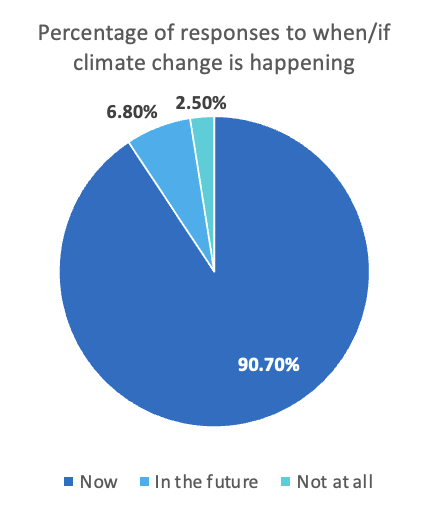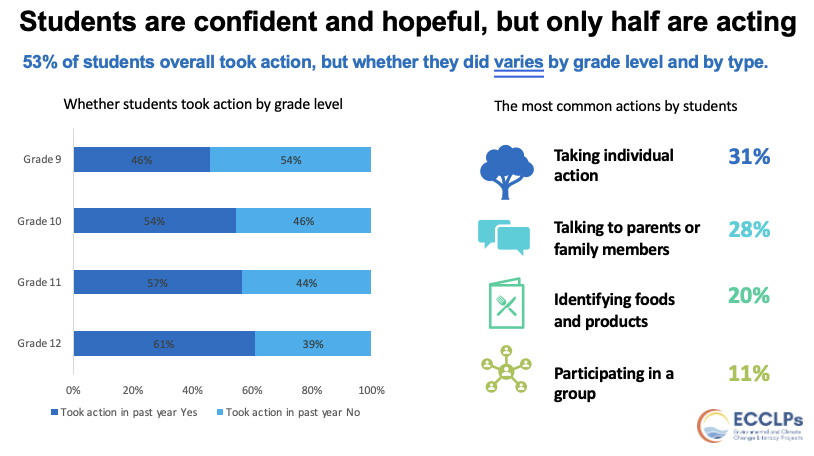High School (Grades 9-12) Student
Climate Change Education Report
Opinions of and experiences with climate change education and action.
Recommended citation: ECCLPs. (2024). ECCLPs HS student survey report. ECCLPs. https://ecclps.net/hs-ss-report
The Survey
As part of its efforts to support PK-12 climate change education in California, ECCLPs collected data on the beliefs and opinions of students in relation to climate change (CC) and their experiences with climate change education (CCE) and action. The survey collected over 2,000 valid responses from California high-school students between September and October 2023.
The survey revealed that over 90% of students believe climate change is happening now, compared to 7% in the future and 3% not at all. 2 in 3 students are concerned or fairly concerned about CC, while 1 in 5 is very concerned.
Most frequently, they attribute CC to fossil fuels, greenhouse gas emissions, cars, factories and people. When asked what they think is the causing climate change, responses varied widely, but the most frequent were the following: fossil fuels (mentioned 283 times), gas/gases (269 times total), pollution (248), carbon (171), emissions (140), cars and factories (each 134), and people (122).
Their concern, however, outsizes their comfort level in explaining these factors and their knowledge of the consequences.
There are a lot of factors that contribute to climate change. However, they all originate from human involvement in the environment.
- Grade 11 student, Southern California
The neglectful and harmful pollution of major corporations around the globe, as well as lack of education and action around climate change.
- Grade 12 student, Northern California
Sources of Climate Change Information
The most common source of information on CC is social media, where 74% of students reported getting information.
*57% of students were sure to have learned about CC in school.
The most common source of information on CC is social media, where 74% of students reported getting information. 62% learn about CC from news media, and fewer from their peers (37%), family (34%), websites of environmental organizations (32%), Earth Day celebrations (27%) and others. Moreover, they are inspired to take action on climate change when they hear about its impacts (60%), by their family (43%), friends or peers (34%), teachers (34%), or stories of other young people taking action (28%).
Climate Change Education
Despite their concern and self-reported lack of fluency in climate-related topics, they don’t perceive schools as doing enough to support them to bridge these gaps.
-
Slightly more than half (56%) were certain that their schools or teachers ever covered CC topics. This was almost always in science (83%) and much less often in history (20%), social studies (13%). It was covered least often in art or music classes (2%).
-
Most often these lessons focus on the role of science and technology in solving CC (48%), effects on human rights and equity (36%), sustainable habits and lifestyles (35%), or analyzing and using data (34%).
-
Students reported least commonly that CC lessons focused on critical thinking and media literacy (20%), political organizing and advocacy (12%), community building (12%) or social emotional skills (10%).
Confidence, Hope, and Action
Students are overall confident in their ability to make a positive impact on the environment through their own actions and hopeful in society’s ability to address climate change.
Half (53%) had taken some type of action on climate change in the past year, most often individual steps like planting a tree or turning off lights (31%), talking to family or friends (28%), or selecting more sustainable foods and products (20%). Fewer had participated in a group on climate change (11%), written letters to their representatives or started a local group or club (6% each). Their interest in further action followed similar patterns.
Whether they were interested in taking action showed clear patterns according to whether they had done so already, with those who took action in the past year more than twice as likely to be interested in taking action in the next three months than those who had not. Kids in action stay in action!
Students who feel “very comfortable” helping the Earth are 8x more likely to be interested in taking action than those who are “not at all comfortable”
Taking action is related to feelings of confidence & hope
When asked how they could feel more comfortable taking action, their responses revealed the importance of peers, friends and school groups as opportunities for collective action matter.
Those who took action had higher mean scores for confidence in their ability to make an impact and hopefulness in society to address climate change than those who had not.
The need for comprehensive climate change education
The analysis revealed that whether students learn about climate change is related to important outcomes. Their level of concern about climate change, their comfort explaining human-related factors contributing to climate change, their perceived knowledge of its effects, and their comfort level taking action were all higher among those whose teachers or classes discussed climate change than among those whose did not.
Perhaps the strongest indicator of the impact of climate change education is whether students are taking action to address it in their communities. Those who learned about climate change were more likely than those who did not to take action, while those who did not learn about it were more likely than those who did to have done nothing.
Importantly, patterns also emerged according to the classes in which students learned about climate change. 81% of those who learned about climate change in art or music took action, compared to 54% of those who learned about it in science class.
Schools should do more to teach young people about climate change, including its impacts, solutions, and how individuals can reduce their carbon footprint. This education can empower students to take action and make informed choices to address climate change.
- Grade 12 student, Southern California
*A special thanks to all our incredible collaborators for sharing about this survey and promoting it through various social media platforms to help us amplify student voices!
Access the summary report from this joint listening session with California partners below.
Recommended citation: ECCLPs. (2024). ECCLPs HS student survey report. ECCLPs. https://ecclps.net/hs-ss-report


















